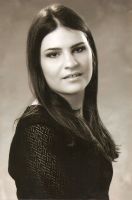Milena Pavlovic Barillis Biography
Milena Pavlovic Barilli, a painter and a poet, was born in Pozarevac, on November 5, 1909, and she was the only child of Danica Pavlovic from Pozarevac, a teacher and a pianist who had been educated at the Conservatory in Munich and the famous Italian composer, musicologist and poet Bruno Barilli, who had converted to an orthodox religion because of his marriage with Danica.
She was educated in Belgrade, in art school, and in 1926 she has continued with her studies in Munich, at Knirr School and at Academy of Fine Arts, until 1928. Both Knirr School and Academy of Fine Arts were known as very good, but conservative schools, which above all, were teaching students to use perfectionism of painting craft and to approach to art traditionally. In order to satisfy her great curiosity and open- mindness which was seeking new sources of experience, and relying on this strong painter`s inner need, sensitivity and personal strength, Milena went to Spain, where she made the series of dramatic and passionate paintings with themes from daily life in Spain.
Then, she continued to improve her painting and her artistic career in other European capitals, first in London, and then she stayed many times in Paris and Rome, where she had solo exhibitions and where she made friends with famous, avant-garde artists, painters, poets, critics. At the same time, she exhibited her paintings in group exhibitions together with our artists in Belgrade and Pozarevac. She had her solo exhibitions in Belgrade and in Pozarevac in 1928 and in 1929, in Paris in 1932 and in 1938, in Rome in 1932 and in 1937, in Florence in 1933, in New York in 1940 and in 1943, in Washington in 1944.
The stylistic development of Milena PB has several stages. The first phase is her education, where one can see refinement of sensitivity, talent, interest in reality-in-picture, which was, however, already associated with the symbolism and art nouveau decoration, usually in fashion design. She uses pastels which further emphasizes smooth transitions and softness of expression.
The second phase is her linear period, tentatively between 1932 and 1936, and since then her powerful visions and a developed system of symbols which still have been painted by light, effortless but confident strokes have become recognizable.
The third phase- the iconography is developing rapidly, bringing enigmatic compositions with allegorical figures, combining the art of memory (as a metaphysical painting of De Chirico and Alberto Savinio) with antique architectural elements, Renaissance mise-en-scene and costumes which are associated with contemporary characters, where she often uses her own image, linking transient and ephermal to permanent and eternal values. Her work is mostly drawn from irrationality, from dreams, from the great masters of art history and from the second wave of surrealism. However, she did not rely on destructiveness in surrealism; she relied on metaphysical relation towards reality, seeking independence, separation from the real world, creating her own world, filled with enduring value system, and thus creating her own mythology.
The fourth, American phase is very nostalgic, with portraits of figures from high society, and with series devoted to religious symbolism, and commercial fashion design, which contributed to the New York fashion scene, while she was working with leading fashion magazines and journals for the interior, Vogue, Harper`s Bazaar, Town and Country, Glamour, Charm.
Milena PB was unknown in our country until the mid 20 century, when Miodrag Protic, setting holdings for future Museum of Contemporary Art in Belgrade, bought several paintings from Milena`s mother in Pozarevac, where almost simultaneously the founding of the memorial gallery was in progress. Protic wrote inspiring essays on Milena`s creativity and her painting was analyzed by Lazar Trifunovic, who was then director of the National Museum in Belgrade, and after that a famous professor of modern art history.
Milena was an execellent portraitist, and she often portraited her father, Bruno Barilli and her mother Danica. Psychological depth of characters is extremely suggestive, the father`s restless spirit and rapture of the composer, and her mother`s sensitivity, sophistication and dedication. In her early period she also painted portraits of movie actors, for example the portrait of Rudolf Valentino, because she was delighted with expressive possibilities which were brought by the new film medium.
She has painted a portrait of Gonzales, a Cuban pianist who was the love of her life, and later a portrait of her husband, an American officer Gosselin. The portrait of the poet Siba Milicic, who was one of Milena`s patrons is also significant and she sold a small picture Composition to him and with that money she bought a ticket to New York, and she went there in September 1939 before the Second World War, which prevented her from returning to Paris and Pozarevac.
